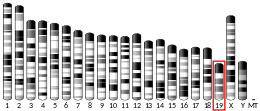SMC5
Structural maintenance of chromosomes protein 5 is a protein encoded by the SMC5 gene in human.[1][2]
The structural maintenance of chromosomes' complex underlying mechanisms involved in the dynamics of chromatin dynamics is unknown, and new discoveries are shedding light on the various functions.[3] The SMC complex mediates long-distance interactions that enable higher-order folding of chromatin in interphase. The SMC complex has an ATPase activity, a conserved kleisin, as well as regulatory subunits.[3] SMC protein complexes are involved in DNA repair, transcriptional pathways, regulation of chromosome segregation, and immunity in Arabidopsis. In eukaryotes the structural maintenance chromosomes consists of cohesin (SMC1 AND SMC3), condensin (SMC2 and SMC4), and SMC5/6 complexes.
Structure
The Smc5/6 complex was discovered in fission yeast. RAD18 (SMC6), the DNA damage gene in fission yeast, also encodes an SMC-like protein and forms a heterodimeric complex with Spr18 (SMC5) protein.[4][5] In yeast, SMC5/6 complex has sub-units which consists of SMC5, SMC6 and six nonstructural maintenance of chromosomes (NSE) proteins. Nse1-Nse3-Nse4 subunits bridge the Smc5 head Smc6 and allow the binding of DNA.
It is involved in the Alternative lengthening of telomeres cancer mechanism.[10]
Role in recombination and meiosis
Smc5 and Smc6 proteins form a heterodimeric ring-like structure and, together with other non-SMC elements, form the SMC-5/6 complex. In the worm Caenorhabditis elegans this complex interacts with the HIM-6(BLM) helicase to promote meiotic recombination intermediate processing and chromosome maturation.[11] The SMC-5/6 complex in mouse oocytes is essential for the formation of segregation competent bivalents during meiosis.[12] In humans, a chromosome breakage syndrome characterized by severe lung disease in early childhood is associated with a mutation in a component of the SMC-5/6 complex.[13] Patient's cells display chromosome rearrangements, micronuclei, sensitivity to DNA damage and defective homologous recombination.
References
- Nagase T, Ishikawa K, Miyajima N, Tanaka A, Kotani H, Nomura N, Ohara O (February 1998). "Prediction of the coding sequences of unidentified human genes. IX. The complete sequences of 100 new cDNA clones from brain which can code for large proteins in vitro". DNA Research. 5 (1): 31–9. doi:10.1093/dnares/5.1.31. PMID 9628581.
- "Entrez Gene: SMC5 structural maintenance of chromosomes 5".
- Jeppsson K, Kanno T, Shirahige K, Sjögren C (September 2014). "The maintenance of chromosome structure: positioning and functioning of SMC complexes". Nature Reviews. Molecular Cell Biology. 15 (9): 601–14. doi:10.1038/nrm3857. PMID 25145851.
- Fousteri MI, Lehmann AR (April 2000). "A novel SMC protein complex in Schizosaccharomyces pombe contains the Rad18 DNA repair protein". The EMBO Journal. 19 (7): 1691–702. doi:10.1093/emboj/19.7.1691. PMC 310237. PMID 10747036.
- Lehmann AR, Walicka M, Griffiths DJ, Murray JM, Watts FZ, McCready S, Carr AM (December 1995). "The rad18 gene of Schizosaccharomyces pombe defines a new subgroup of the SMC superfamily involved in DNA repair". Molecular and Cellular Biology. 15 (12): 7067–80. doi:10.1128/mcb.15.12.7067. PMC 230962. PMID 8524274.
- GRCh38: Ensembl release 89: ENSG00000198887 - Ensembl, May 2017
- GRCm38: Ensembl release 89: ENSMUSG00000024943 - Ensembl, May 2017
- "Human PubMed Reference:". National Center for Biotechnology Information, U.S. National Library of Medicine.
- "Mouse PubMed Reference:". National Center for Biotechnology Information, U.S. National Library of Medicine.
- Potts PR, Yu H (July 2007). "The SMC5/6 complex maintains telomere length in ALT cancer cells through SUMOylation of telomere-binding proteins". Nature Structural & Molecular Biology. 14 (7): 581–90. doi:10.1038/nsmb1259. PMID 17589526.
- Hong Y, Sonneville R, Agostinho A, Meier B, Wang B, Blow JJ, Gartner A (March 2016). "The SMC-5/6 Complex and the HIM-6 (BLM) Helicase Synergistically Promote Meiotic Recombination Intermediate Processing and Chromosome Maturation during Caenorhabditis elegans Meiosis". PLoS Genetics. 12 (3): e1005872. doi:10.1371/journal.pgen.1005872. PMC 4807058. PMID 27010650.
- Hwang G, Sun F, O'Brien M, Eppig JJ, Handel MA, Jordan PW (May 2017). "SMC5/6 is required for the formation of segregation-competent bivalent chromosomes during meiosis I in mouse oocytes". Development. 144 (9): 1648–1660. doi:10.1242/dev.145607. PMC 5450844. PMID 28302748.
- van der Crabben SN, Hennus MP, McGregor GA, Ritter DI, Nagamani SC, Wells OS, et al. (August 2016). "Destabilized SMC5/6 complex leads to chromosome breakage syndrome with severe lung disease". The Journal of Clinical Investigation. 126 (8): 2881–92. doi:10.1172/JCI82890. PMC 4966312. PMID 27427983.
Further reading
- Nakajima D, Okazaki N, Yamakawa H, Kikuno R, Ohara O, Nagase T (June 2002). "Construction of expression-ready cDNA clones for KIAA genes: manual curation of 330 KIAA cDNA clones". DNA Research. 9 (3): 99–106. CiteSeerX 10.1.1.500.923. doi:10.1093/dnares/9.3.99. PMID 12168954.
- Taylor EM, Moghraby JS, Lees JH, Smit B, Moens PB, Lehmann AR (June 2001). "Characterization of a novel human SMC heterodimer homologous to the Schizosaccharomyces pombe Rad18/Spr18 complex". Molecular Biology of the Cell. 12 (6): 1583–94. doi:10.1091/mbc.12.6.1583. PMC 37326. PMID 11408570.
- Potts PR, Yu H (August 2005). "Human MMS21/NSE2 is a SUMO ligase required for DNA repair". Molecular and Cellular Biology. 25 (16): 7021–32. doi:10.1128/MCB.25.16.7021-7032.2005. PMC 1190242. PMID 16055714.
- Potts PR, Porteus MH, Yu H (July 2006). "Human SMC5/6 complex promotes sister chromatid homologous recombination by recruiting the SMC1/3 cohesin complex to double-strand breaks". The EMBO Journal. 25 (14): 3377–88. doi:10.1038/sj.emboj.7601218. PMC 1523187. PMID 16810316.



